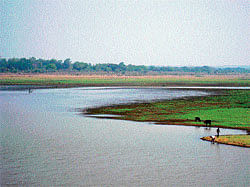A historic 'kere' now gone dry

Hesarghatta in Bangalore North is around 25 km away from the city, off the NH4. It is home to a huge tank, several government institutions, poultry farms and a few decades back, Protima Bedi’s austere dance school, Nrityagram.
Though the chief attraction today is Nrityagram, Hesarghatta kere held that position until the Eighties and had once been the major source of water to the City.
As we drive through Outer Ring Road that leads to Tumkur, there are plenty of stalls selling fruits, condiments and small hotels where you can stop for a quick bite.
A few kilometres further, we cross Chikkabanavara railway station. It reminds me of the Srirangapatna railway station, charmingly small and simple. The urban scene is increasingly greener and unspoilt by realty boards yet. On either side are cultivable lands, plantations and farm houses. The nagara (urban areas) ends and gradually the hallis (villages) start. Soladevanahalli, Tharabanahalli, Kumbarhalli, Hesarghatta, Aivarkhandapura, Siluvepura and the list goes on.
There’s an old BWSSB pump station at Soladevanahalli that can still be used for whatever water the Hesarghatta tank can provide. The building is off set from the main road and looks easily a hundred years old. With arched windows and doors and a pink bougainvillea creating a flowery porch, it’s very charming and quiet.
As we go further, we can see a few defence establishments. The board on the main road leads us to the Hesarghatta tank bund. A set of stairs leads us upwards. The huge area, mostly dry, has some water body. A group of fishermen are trying their luck for the day.Some birds also have the same intent. I could spot a horde of magpie robins, kingfishers and a few Brahminy kites with my little knowledge of bird species.
Hesarghatta is home to many water birds and this is a good place to some serious avian photography.
The making of the tank
An anecut or bund had been constructed around 1532 AD. ‘Epigraphica Carnatica’ informs us of a Vijayanagara inscription that states that an anecut was built on the banks of the Arkavathi river and a Chandramoulishwara temple was constructed near the anecut. An agrahara was formed here and since then, this place was renamed as Siva Samudra Agrahara.
The making of the bund and the renaming must have been during the time of King Achutaraya of the Tuluva dynasty of Vijayanagar rulers. B L Rice writes in the Mysore Gazetteer that the King Achutaraya, pleased with Kempegowda I, liberally bestowed twelve hoblis (settlements), one of which was Hesarghatta.
The tank served irrigation and domestic water for the settlements around it. It was only in the late nineteenth century that it was expanded and comprehensively redone to supply the first protected water supply to Bangalore.
In his book, ‘Bangalore through Centuries’, Fazlul Hasan colourfully narrates the entire Hesarghatta project. He credits the then Maharaja Chamarajendra Wodeyar and Dewan K Seshadri Iyer for taking the cause of providing water to Bangalore.
The project started in 1894 cost Rs 20,78,641, a big amount in those days! A brick aqueduct brought water from the kere to Turabanahalli. Here the water was filtered and chlorinated. It then flowed to Soladevanahalli reservoir from where steam pumps were used to pump it up to Chimney Hills. From here the water flowed to the Jewel Filters at Malleswaram and was then distributed to the entire city.
Water flowed into homes in both City and Civil and Military Station (cantonment) in mid 1896. Until the Tippagondanahalli tank was constructed in 1933, this reservoir was the main water source for the city.
The then Dewan K Sheshadri Iyer and the then chief engineer of Mysore M C Hutchins played a key role, in the development of the Hesarghatta water supply scheme which came to be called the Chamarajendra water works. The reservoir with a catchment area of 474 sq km, with 184 tanks in its upper catchment used to supply 36 million litres per day of water explains S Vishwanath, one of the key advisors to Arghyam, an NGO working in the water and sanitation sector.
Today, a water tanker provides water to the houses just behind the bund. A decade-old well in one of the homes has been dry for a few years. Vishwanath explains that there is a necessity to understand the changes in the catchment of the Arkavathi and look at reviving the river and regenerating flows.
Other institutions
Many government Institutions dot the area around the kere. There’s a Horticulture Research Institute, a Central Duck Breeding Farm and the Government Aquarium. The institutes that rose here due to availability of water now are probably facing difficult times now.
The people who visit the spot today typically come to see Nrityagram and round it off with a sumptuous lunch at a restaurant opposite. Walking along the tank bund, I just hope one day, I can see the entire kere, brimming with water, just like it might have been until the Seventies.
Getting there and around
One has to drive on the Outer Ring Road towards Tumkur. Don’t take the flyover, but drive under it until you get the Hesarghatta cross. Driving is less hectic once you turn off the Tumkur road traffic onto Hesarghatta Main road.
Deccan Herald is on WhatsApp Channels | Join now for Breaking News & Editor's Picks